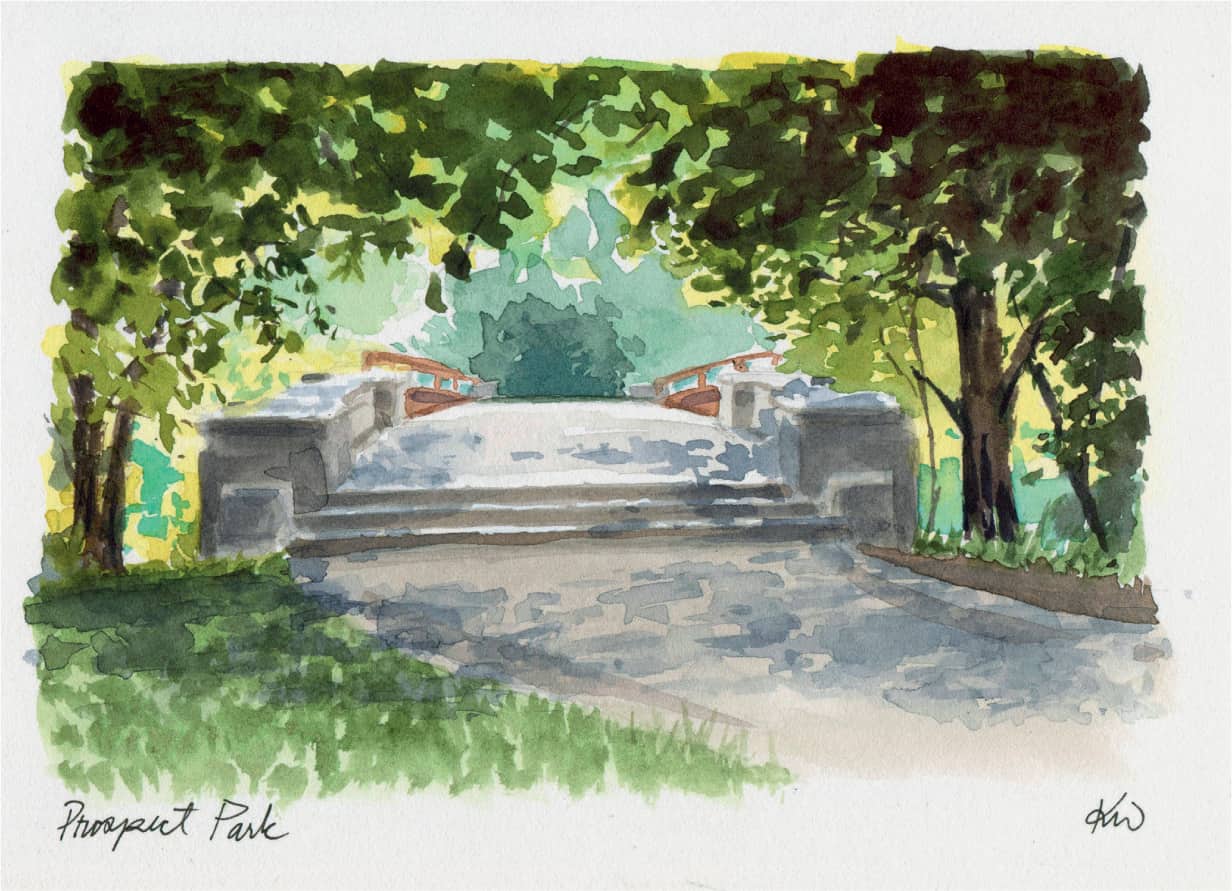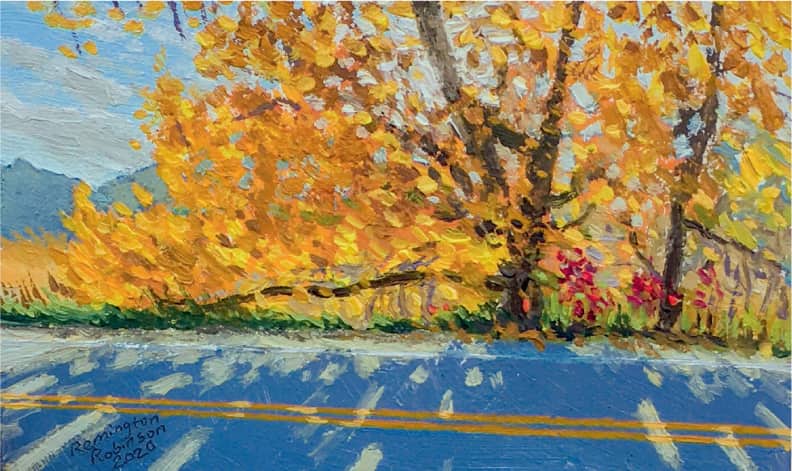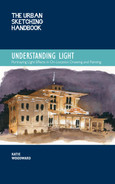
KEY V
FOLIAGE
Foliage can feel intimidating to sketch, in part because the lighting schemes are so complex! Having to figure out what is being hit by light, what is in shadow, and what light is filtering through translucent leaves can be overwhelming. As with anything else, it takes practice, but it gets easier if we better understand what we are looking at and simplify as necessary. Let’s demystify the process a bit.

ROOI PING LIM
Relaxing After a Long Day, Utungun Hall, Untungun, NSW, Australia
8" x 10¼" | 20 x 26 cm; pencil and watercolor; 1 hour
WARM GREENS VERSUS COOL GREENS
One of the hardest things about painting foliage is that it is translucent, which lends itself to a wide range of greens, even on the same plant. You can have light hitting the front of one leaf, next to another where you are seeing the light filter through from behind. It is sometimes easiest to group together pieces of foliage where possible, finding a color that can suit a whole area that averages together the large variety of colors and values that can be visible in foliage. Use the marks made on the edge of your shape, and perhaps some marks made within, to help define it as foliage, rather than worrying about each individual leaf.

YONG HONG ZHONG
Plein Air Painting at Downtown Lake Oswego, Lake Oswego, Oregon
8" x 10" | 20.3 x 25.4 cm; watercolor; 1 hour
Letting bits of light sky peek through the foliage helps show the texture of leaves without having to sketch every individual leaf with its own highlights and shadows.

SHARI BLAUKOPF
School District, Montreal, Canada
8" x 8" | 20.3 x 20.3 cm; watercolor, pencil; 1 hour

JULIANNA COX
River Afternoon, Elora, Ontario, Canada
6" x 8" | 15.2 x 20.3 cm; watercolor
Leaves being hit with light can glow warm, especially when lit from behind! This can also happen with flowers and other translucent objects.
Observation Checklist
 Are the majority of the leaves in shadow, frontlit, or backlit?
Are the majority of the leaves in shadow, frontlit, or backlit?
 Are backlit leaves warmer or cooler than frontlit leaves? Leaves in shade?
Are backlit leaves warmer or cooler than frontlit leaves? Leaves in shade?
 What are the dappled shadow shapes of the cast shadow? Do you see any trunk or branch shadows?
What are the dappled shadow shapes of the cast shadow? Do you see any trunk or branch shadows?
 Can you combine a piece of foliage into groups? Maybe by tree, or by groupings of trees?
Can you combine a piece of foliage into groups? Maybe by tree, or by groupings of trees?
SHADOWS UNDER FOLIAGE
With foliage, it’s easy to get caught up in all the leaves, but don’t forget about what supports those leaves! Showing where the trunk and branches of a tree show through can give the viewer useful information, making these details more important to a composition than the actual foliage. It can transform indistinct green shapes into a tree, with just a few strokes. How dense are the trees? In the treetops, foliage may all blend together, but closer to the ground you’ll be able to see the tree’s trunk between them. At the trunk height you may see light coming through from beyond, or you may have a forest where you are seeing mostly shadow.

KATIE WOODWARD
Gramercy Park, New York City
3" x 4" | 7.6 x 10.2 cm; watercolor graphite pencil, Pigma Micron pens

SHARI BLAUKOPF
Windy Park, Montreal, Canada
16" x 8" | 40.6 x 20.3 cm; watercolor; 1 hour
When at the edge of a wooded area, the space beyond the tree trunks may be in shadow, causing the trunks to appear light against the darkness.

KATIE WOODWARD
Central Park Conservatory Waters, New York City
4" x 4" | 10.2 x 10.2 cm; watercolor, graphite pencil, Pigma Micron pen, white Uni-ball Signo gel pen
SUNBEAMS
As light pours through foliage, you may see sunbeams. They can be especially prominent when there is a lot of dust, moisture, or smoke in the air for light to catch. The sun hits these particles and you can see the path of the sun as it passes through leaves or clouds as a three-dimensional object. Or, conversely, with similar conditions you can have a shadow beam if instead of having mostly shadow and a little sun, you have mostly sun with only a little blocked out (like sun on a building casting a huge shadow, or sun on a single tree or gravestone.).

YONG HONG ZHONG
Plein Air Painting at Downtown Lake Oswego, Lake Oswego, Oregon
7" x 10" | 17.8 x 25.4 cm; watercolor; 1 hour

KATIE WOODWARD
Sunbeams in Autumn, Prospect Park, Brooklyn, New York
5" x 7" | 12.7 x 17.8 cm; watercolor, graphite pencil, white gel pen
DAPPLED LIGHT
Aside from the foliage itself, we have to figure out how the light filters through the leaves. This can create tangled shadow patterns of dappled light on the ground, but just because they look complicated doesn’t mean sketching them has to be!
Try looking at these shadows as a single, broken shape. Like a slice of swiss cheese, the shadow shape will have holes in it. Instead of having to paint the shadow of each individual leaf, play with the outline of the shadow, leaving unpainted areas within it to give the idea of dappled light. If you are working in an opaque medium, you can add dots of light back in over your shadow, or if you are using graphite, you can erase out areas.

KATIE WOODWARD
Shakespeare Garden, New York City
3" x 3" | 7.6 x 7.6 cm; watercolor, graphite pencil, white Uni-ball Signo gel pen

KATIE WOODWARD
Prospect Park, Brooklyn, New York
5" x 7" | 12.7 x 17.8 cm; watercolor and graphite pencil
Another approach: adding the shadows in layers. By dotting in the shadows and placing shadow shape atop shadow shape, it gives the impression the leaves are more translucent and the light hitting the ground is filtered through the leaves themselves, rather than just around them. For this sketch I added one larger shadow shape then proceeded to add layers of dashed shadows on top, as the dappled light I was seeing was very broken up, sometimes the light on the ground was pure sun, other times it was filtered through translucent leaves.
Gallery: Dappled Light

HEATHER SOULIERE
Fountain on Bute Street, Vancouver, Canada
4" x 6½" | 10.1 x 16.6 cm; HB pencil, Speedball Super Black India Ink mixed with water, Sakura Micron pen Size 01, watercolor paint brush, Moleskine Sketchbook; 1½ hours

HEATHER SOULIERE
Morning Light, Vancouver, Canada
4" x 6½" | 10.1 x 16.6 cm; HB pencil, Speedball Super Black India Ink mixed with water, Sakura Micron pen size 01, watercolor paintbrush, Moleskine sketchbook; 1 hour

REMINGTON ROBINSON
Roadside Cottonwood Tree in Autumn, Colorado
1⅞" x 3⅛" | 4.64 x 7.94 cm; oil on wood panel
See the variety in the foliage: the brighter yellow backlit leaves, and the more ochre leaves in shadow.

ALEX SNELLGROVE
The Garden Gate, Blackheath, Blackheath, Australia
8¼" x 11¾" | 21 x 29.8 cm (A4); markers (Posca, Tombow, Fineliner) and watercolor pencils on a prepared acrylic background of mostly blue and purple (not made specifically for this); 1½ hours
“Late afternoon sunlight filters through the leaves of the crabapple tree and casts dappled shadows on the slats of the open gate. The road outside is bright with sunlight, which also catches the tips of the agapanthus flowers next to the path.” —Alex Snellgrove
Observation Checklist
 What is the shape of the dappled shadows you see on the ground?
What is the shape of the dappled shadows you see on the ground?
 Within the dappled shadow, is there more shadow or light?
Within the dappled shadow, is there more shadow or light?
 Do you see any shadows of branches or trunks cutting across?
Do you see any shadows of branches or trunks cutting across?
 Is the dappled shadow only on the ground, or is it also on nearby building walls, tree trunks, or other objects?
Is the dappled shadow only on the ground, or is it also on nearby building walls, tree trunks, or other objects?
 Are the shadows wrapping around surfaces they cross and conforming to those shapes?
Are the shadows wrapping around surfaces they cross and conforming to those shapes?
 Are the edges of the shadow hard or soft?
Are the edges of the shadow hard or soft?
GALLERY: FOLIAGE

DAVID LOWTHER
Sett Valley Trail, Derbyshire, United Kingdom
8" x 11" | 20.3 x 27.9 cm; pastel and Viarco ArtGraf; 30 minutes
Add mood by blocking in light with dark shadows.

DOUG RUSSELL
Sanur, Bali, Indonesia
15" x 11" | 38.1 x 27.9 cm; Prismacolor pencil on brown Stonehenge paper; 2 hours

ROOI PING LIM
Leigh’s Shed, Wyong Creek, NSW Australia
8" x 10" | 20 x 25 cm; pen and watercolor; 45 minutes

ROOI PING LIM
Path on the Way Home, Wyong Creek, NSW Australia
10" x 8" | 26 x 20 cm; pencil and watercolor; 45 minutes
